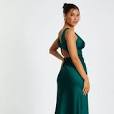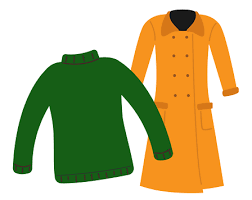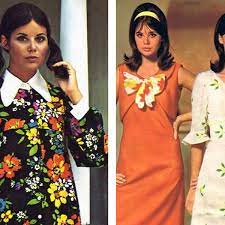The 1960s was a decade that brought about significant changes in fashion, particularly for women. It was a time of revolution and self-expression, and the fashion of the era reflected these societal shifts. From the iconic mod style to the bohemian hippie look, 60s fashion for women was diverse, bold, and influential.
One of the most defining styles of the 60s was the mod fashion. Inspired by the youth-driven culture of London’s Carnaby Street, mod fashion embraced clean lines, geometric patterns, and vibrant colors. Women embraced mini skirts that showcased their legs and paired them with knee-high boots for a sleek and futuristic look. The shift dress became a staple, characterized by its simple silhouette and bold patterns such as checks or polka dots.
Another prominent style during this era was influenced by the bohemian counterculture movement. The hippie fashion emerged as a rejection of mainstream values and embraced a more relaxed and free-spirited approach to dressing. Flowing maxi dresses with floral prints, fringed vests, bell-bottom trousers, and peasant blouses were all key elements of this boho-chic aesthetic. Accessories like headbands, oversized sunglasses, and beaded jewelry completed the look.
In terms of hair and makeup, the 60s witnessed some iconic trends that are still celebrated today. Women experimented with beehive hairstyles or opted for sleek pixie cuts inspired by supermodel Twiggy. Bold eye makeup took center stage with dramatic winged eyeliner and heavy mascara to achieve that wide-eyed doe look.
The influence of 60s fashion can still be seen in contemporary styles today. The mini skirt remains a wardrobe staple for many women around the world, while mod-inspired patterns continue to make appearances on runways season after season. The bohemian aesthetic has also experienced a resurgence in recent years with its emphasis on flowy silhouettes and natural fabrics.
The 60s was a decade of liberation and self-expression for women, and the fashion of the era reflected this spirit. Whether it was the mod style or the bohemian hippie look, women embraced bold and innovative fashion choices that continue to inspire us today. The legacy of 60s fashion lives on, reminding us to embrace our individuality and celebrate our own unique style.
The Enduring Allure of 60s Fashion for Women
- Timeless style
- Versatility
- Comfort
- Variety
- Quality construction
Drawbacks of 60s Fashion for Women: Limited Choices, Unflattering Cuts, Lack of Colour, Uncomfortable Fabrics, and High Heel Woes
- Limited choice of clothing styles and materials.
- Unflattering cuts and silhouettes that do not flatter all body types.
- Lack of colour options for women’s clothing, with pastel shades being the most popular choice.
- Uncomfortable fabrics such as polyester and nylon that are not breathable or stretchy enough for movement and comfort.
- High heels were often a necessity to complete an outfit, making them uncomfortable to wear for long periods of time or on uneven surfaces.
Timeless style
Timeless style: 60s fashion women’s clothing is characterized by timeless, classic silhouettes and styles that have been popular for decades.
The fashion of the 1960s was not just a passing trend; it left an indelible mark on the world of style. One of the greatest pros of 60s fashion for women is its timeless appeal. The clothing designs from this era continue to inspire and influence modern fashion, proving that good style never goes out of fashion.
The iconic silhouettes and styles of the 60s have stood the test of time. Take, for example, the shift dress. Its simple yet elegant shape has remained a staple in many women’s wardrobes throughout the years. The A-line skirt, another hallmark of 60s fashion, continues to be a versatile piece that can be dressed up or down for various occasions.
Moreover, classic patterns and prints from this era still find their way onto runways and into everyday wear. The polka dots, checks, and bold geometric patterns that defined 60s fashion continue to add a touch of retro flair to contemporary outfits. These prints have proven their longevity by transcending generations and remaining relevant even today.
In addition to silhouettes and patterns, certain accessories from the 60s have become timeless staples as well. The oversized sunglasses popularized by style icons like Audrey Hepburn and Jackie Kennedy are still considered chic and fashionable today. Similarly, headscarves and statement jewelry pieces like chunky bracelets or statement earrings continue to elevate outfits with a touch of vintage glamour.
The enduring popularity of 60s fashion can be attributed to its ability to adapt to different times while retaining its core elements. Designers often revisit this era for inspiration, reimagining classic styles with modern twists. This fusion allows women to embrace the elegance and sophistication associated with 60s fashion while incorporating contemporary trends seamlessly.
In conclusion, one of the greatest pros of 60s fashion for women is its timeless style. The silhouettes, patterns, and accessories from this era have proven their lasting appeal, remaining relevant and influential in the world of fashion. By incorporating elements of 60s fashion into our wardrobes, we can embrace a sense of timeless elegance that transcends passing trends and allows us to express our personal style with confidence.
Versatility
One of the standout advantages of 60s fashion for women was its incredible versatility. The clothing of this era had the unique ability to be dressed up or down for any occasion, making it a truly adaptable style choice.
Whether it was a casual day out or a formal evening event, women in the 60s could easily transform their outfits with the right accessories. This versatility allowed them to express their personal style while still adhering to the appropriate dress code.
For a more casual look, women could opt for a mod-inspired shift dress paired with knee-high boots and statement sunglasses. This ensemble exuded an air of youthful energy and rebellion, perfect for a day spent exploring city streets or attending a casual gathering with friends.
On the other hand, when attending more formal events, women could elevate their outfits by accessorizing with elegant pieces. A simple shift dress could be transformed into an evening gown with the addition of a statement necklace, glamorous heels, and an elegant clutch. This adaptability made 60s fashion suitable for both daytime and evening occasions without sacrificing style or sophistication.
The ability to dress up or down 60s fashion also meant that women could get more mileage out of their wardrobe. By investing in versatile pieces that could be styled differently depending on the occasion, they were able to create numerous looks without needing an extensive collection of clothing.
Today, this versatility continues to inspire modern fashion trends. The concept of dressing up or down an outfit remains popular as people seek ways to maximize their wardrobe’s potential. The influence of 60s fashion can be seen in contemporary styles that prioritize adaptability and individual expression.
In conclusion, one of the notable pros of 60s fashion for women was its versatility. With the right accessories and styling choices, clothing from this era could effortlessly transition from casual to formal settings. This adaptability not only allowed women to express their personal style but also provided them with practicality and value for their fashion choices.
Comfort
One of the notable advantages of 60s fashion for women was its emphasis on comfort. During this era, many of the fabrics used in clothing were light and breathable, allowing women to feel comfortable and at ease throughout their daily activities.
Gone were the restrictive corsets and heavy fabrics of previous decades. Instead, women embraced fabrics like cotton, linen, and jersey that offered a relaxed fit and allowed for ease of movement. These materials were not only comfortable but also practical for everyday wear.
The shift dress, a popular style during the 60s, exemplified this focus on comfort. Its loose silhouette and lightweight fabrics made it an ideal choice for women who wanted to look stylish without sacrificing comfort. Paired with flat shoes or low-heeled boots, these dresses provided a sense of freedom and ease that was liberating for women.
Furthermore, the rise of casual fashion during this period allowed women to adopt more relaxed styles in their everyday wardrobes. Women could opt for trousers or jeans instead of skirts or dresses when they desired a more laid-back look. This shift in fashion norms gave women greater flexibility and comfort in their daily attire.
The emphasis on comfort in 60s fashion not only revolutionized dressing but also had a lasting impact on subsequent decades. The idea that clothing should be both stylish and comfortable became ingrained in modern fashion sensibilities.
Today, we continue to see the influence of 60s fashion’s focus on comfort in contemporary styles. The popularity of athleisure wear, loose-fitting dresses made from natural fibers, and the resurgence of wide-leg trousers all reflect this ongoing desire for comfortable yet fashionable clothing options.
In conclusion, one cannot overlook the pro of comfort when discussing 60s fashion for women. The light and breathable fabrics used during this era provided a welcome change from the constricting garments of previous decades. This emphasis on comfort not only allowed women to move freely but also paved the way for more relaxed and practical styles that continue to shape fashion today.
Variety
One of the standout pros of 60s fashion for women was the incredible variety it offered. From bold colours to delicate prints, there was an abundance of options available in women’s clothing during this era.
The 60s witnessed a departure from the more conservative styles of previous decades, and women embraced a newfound sense of freedom and self-expression through their clothing choices. This shift allowed for a diverse range of styles to emerge, catering to different tastes and preferences.
Bold colours were a prominent feature of 60s fashion. Vibrant shades like electric blue, hot pink, and sunny yellow were popular choices that added a sense of energy and excitement to outfits. Women could experiment with eye-catching colour combinations or opt for monochromatic looks that made a strong statement.
In addition to bold colours, delicate prints also took center stage. Floral patterns, paisley designs, and psychedelic prints became synonymous with the era. These intricate prints allowed women to express their individuality and showcase their artistic side through their clothing.
The variety in 60s fashion extended beyond just colour and print. Different silhouettes were embraced during this time, catering to various body types and personal styles. From the mod-inspired shift dresses that hung straight down from the shoulders to the flowing maxi dresses that exuded bohemian charm, there was something for everyone.
This wide range of options allowed women to experiment with different looks and find styles that suited their personalities. It gave them the freedom to express themselves through fashion in a way that had not been seen before.
Even today, we can draw inspiration from the variety seen in 60s fashion for women. The bold use of colour and playful prints continue to influence contemporary designs, reminding us that fashion is meant to be fun and expressive.
The variety offered by 60s fashion is undoubtedly one of its greatest strengths. It celebrated individuality and provided women with endless possibilities when it came to creating unique and memorable looks. The legacy of this era’s fashion continues to inspire us to embrace diversity and explore our personal style with confidence.
Quality construction
One of the notable advantages of 60s fashion for women was the exceptional quality of construction and craftsmanship. During this era, manufacturers paid meticulous attention to detail, resulting in garments that were often superior in quality compared to modern clothing.
In the 1960s, the fashion industry prioritized durability and longevity. Garments were constructed with precision and care, using high-quality materials that stood the test of time. From tailored suits to elegant dresses, every piece was made with a focus on longevity rather than fast fashion trends.
The attention to detail in 60s fashion was evident in the stitching, seams, and finishes. The garments were meticulously sewn together, ensuring that they would withstand repeated wear and washing without losing their shape or integrity. The craftsmanship extended to buttons, zippers, and other fastenings, which were often sturdier and more durable than those found on modern clothing.
Moreover, the use of high-quality fabrics was another contributing factor to the superior construction of 60s fashion. Natural fibers like wool, silk, and cotton were commonly used, offering not only comfort but also durability. These fabrics were carefully selected for their ability to retain their shape and resist wear over time.
The emphasis on quality construction in 60s fashion meant that women could invest in timeless pieces that would last for years. Unlike today’s fast-fashion culture where garments are often disposable after a few wears or washes, women in the 60s valued clothing as long-term investments.
While modern manufacturing techniques have brought convenience and affordability to the fashion industry, there is something special about the craftsmanship found in 60s fashion. The attention to detail and commitment to quality construction resulted in garments that have stood the test of time.
Today, many vintage enthusiasts seek out original 60s pieces for their superior construction and timeless appeal. The enduring popularity of vintage clothing from this era serves as a testament to its exceptional quality.
In an era where fashion is often mass-produced and disposable, the quality construction of 60s fashion women stands as a reminder of the value of craftsmanship and attention to detail. It is a testament to an era when garments were made to last, reflecting a time when quality was paramount in the world of fashion.
Limited choice of clothing styles and materials.
While the 1960s brought about a revolution in fashion for women, it also had its drawbacks. One notable con of 60s fashion for women was the limited choice of clothing styles and materials available during that time.
During this era, certain styles dominated the fashion scene, such as the mod and bohemian looks. While these styles were undoubtedly iconic and influential, they often overshadowed other fashion choices. This limited variety meant that women who didn’t resonate with these specific styles had fewer options to express their personal taste and individuality.
Additionally, the materials used in 60s fashion were often limited as well. Synthetic fabrics like polyester gained popularity due to their affordability and durability. While these fabrics offered convenience, they lacked the natural breathability and comfort of traditional materials like cotton or silk. This limitation in material choices may have hindered some women from finding clothing that suited their preferences or provided optimal comfort.
Furthermore, societal norms at the time dictated certain dress codes for different occasions. Women were expected to adhere to specific standards of femininity and modesty, which further restricted their choices when it came to clothing styles.
However, it is important to note that despite these limitations, there were still women who pushed boundaries and experimented with alternative styles. They sought out unique vintage pieces or created their own garments as a means of self-expression.
In retrospect, the limited choice of clothing styles and materials in 60s fashion can be seen as a reflection of the cultural context of that era. While it may have posed challenges for some women seeking diversity in their wardrobes, it also served as a catalyst for future generations to embrace a wider range of fashion options and break free from restrictive norms.
Today, we can appreciate both the strengths and limitations of 60s fashion for women. It serves as a reminder of how far we’ve come in terms of inclusivity and diversity within the fashion industry – allowing individuals to express themselves through a vast array of styles, materials, and personal preferences.
Unflattering cuts and silhouettes that do not flatter all body types.
While 60s fashion for women brought about many iconic and influential styles, it is important to acknowledge that there were also some drawbacks. One of the cons of 60s fashion was the prevalence of unflattering cuts and silhouettes that did not necessarily flatter all body types.
During this era, the mod fashion movement popularized mini skirts and shift dresses. While these styles were celebrated for their youthful and daring appeal, they did not always suit every body shape. The straight and boxy silhouette of shift dresses, for example, could be unflattering on curvier figures, as they lacked definition and failed to accentuate natural curves.
Similarly, the mini skirt trend could pose challenges for those who were not comfortable showcasing their legs or had concerns about modesty. The emphasis on short hemlines meant that women with longer torsos or fuller figures may have struggled to find styles that suited their proportions.
Additionally, the mod fashion movement often prioritized a slim and boyish figure as the ideal. This narrow focus on a specific body type excluded women with different shapes and sizes from fully embracing the trends of the time. It limited options for those who didn’t fit into the desired mold, leading to feelings of exclusion or self-consciousness.
However, it is important to remember that fashion is constantly evolving and adapting to cater to a wider range of body types. While 60s fashion may have had its limitations in terms of inclusivity, it also paved the way for future movements that celebrated diversity in size and shape.
Today’s fashion industry has made significant strides towards inclusivity by embracing body positivity and offering a wider range of sizes and styles. We now have a greater understanding that fashion should empower all individuals, regardless of their body type or size.
In retrospect, while 60s fashion may have had its drawbacks in terms of unflattering cuts and silhouettes for all body types, it served as a stepping stone towards a more inclusive and diverse fashion landscape that we continue to strive for today.
Lack of colour options for women’s clothing, with pastel shades being the most popular choice.
While 60s fashion for women was undoubtedly revolutionary and influential, it did have its drawbacks. One notable con of this era’s fashion was the limited range of colour options available for women’s clothing, with pastel shades being the most popular choice.
During the 1960s, pastel colours dominated the fashion scene. Soft pinks, baby blues, mint greens, and pale yellows were commonly seen in dresses, blouses, and skirts. While these colours exuded femininity and elegance, they left little room for experimentation or personal expression when it came to colour choices.
This lack of variety in colour options may have been influenced by societal norms and expectations at the time. Pastel shades were associated with traditional femininity and were considered appropriate for women in both formal and casual settings. However, this limited palette may have left some women feeling restricted in their self-expression through clothing.
Additionally, the focus on pastels meant that other vibrant or bold colours were often overlooked. Women who preferred richer hues or wanted to make a bolder statement through their clothing choices may have felt somewhat excluded by the prevailing trend.
It is important to note that this con was not universal or experienced by all women during the 60s. Many individuals embraced pastels and found joy in their soft and delicate charm. However, for those who desired a broader spectrum of colours to reflect their personality or match their personal style preferences, the predominance of pastel shades could be seen as a limitation.
Despite this con, it is crucial to acknowledge that 60s fashion also brought about significant advancements in terms of style experimentation and breaking away from traditional norms. The era witnessed groundbreaking changes that paved the way for more diverse fashion options in subsequent decades.
In conclusion, while 60s fashion for women had its limitations when it came to colour choices with a heavy emphasis on pastel shades, it also marked an important period of liberation and self-expression. The fashion of the era played a crucial role in challenging societal norms, paving the way for more diverse and inclusive fashion choices in the years to come.
Uncomfortable fabrics such as polyester and nylon that are not breathable or stretchy enough for movement and comfort.
While 60s fashion for women brought about a wave of innovation and self-expression, it also had its fair share of drawbacks. One significant con of 60s fashion was the prevalent use of uncomfortable fabrics like polyester and nylon.
During this era, synthetic fabrics gained popularity due to their affordability and versatility. However, they often lacked the breathability and stretchiness that are essential for movement and comfort. Polyester and nylon were commonly used in clothing items such as dresses, blouses, and trousers, which unfortunately resulted in a less-than-ideal wearing experience.
Polyester, known for its wrinkle resistance and durability, often had a stiff and plasticky feel against the skin. It did not allow proper airflow, causing discomfort during warmer weather or prolonged periods of wear. Similarly, nylon was also not breathable enough, trapping heat and moisture against the body.
Furthermore, these fabrics lacked stretchiness, making it challenging to move freely or engage in physical activities comfortably. Restrictive clothing made it difficult for women to fully enjoy their day-to-day activities without feeling constricted or limited in their movements.
Fortunately, fashion has come a long way since the 60s. Today’s designers prioritize using breathable fabrics that allow for comfortable movement while still maintaining style. Natural fibers like cotton or linen are popular choices due to their breathability and softness against the skin. Additionally, advancements in textile technology have led to the development of innovative synthetic fabrics that offer both comfort and functionality.
Although uncomfortable fabrics were a drawback of 60s fashion for women, it is important to recognize that this era also paved the way for advancements in textile manufacturing. The lessons learned from those experiences have contributed to creating more comfortable and wearable fashion choices today.
High heels were often a necessity to complete an outfit, making them uncomfortable to wear for long periods of time or on uneven surfaces.
While 60s fashion for women brought about numerous iconic trends, it also had its fair share of drawbacks. One such con was the insistence on high heels as a necessity to complete an outfit. While they undoubtedly added a touch of glamour and elegance, they often proved uncomfortable to wear for long periods of time or on uneven surfaces.
During the 1960s, high heels were considered an essential component of a woman’s ensemble, particularly for formal occasions or when aiming for a more polished look. However, these fashionable footwear choices came with their own set of challenges. The slender stiletto heels that were in vogue during this era offered little stability, making them difficult to walk in and potentially hazardous on uneven surfaces.
Moreover, the discomfort caused by prolonged wear of high heels was another downside. Women often found themselves enduring sore feet and cramped toes after spending hours in these stylish yet impractical shoes. The lack of cushioning and arch support meant that wearing high heels for extended periods could lead to foot pain and even long-term foot problems.
As fashion evolved over time, there has been a shift towards prioritizing comfort without sacrificing style. Today, women have more options available to them, including stylish flats, block heels, or supportive footwear designed to provide both comfort and fashion-forward looks.
While high heels undoubtedly played a significant role in 60s fashion for women, it is important to acknowledge the discomfort and potential risks associated with them. As we continue to embrace fashion trends from different eras, it is essential to prioritize our comfort and well-being without compromising on style. Ultimately, finding a balance between fashion and practicality allows us to feel confident and comfortable in our own skin while making a statement with our personal style choices.




